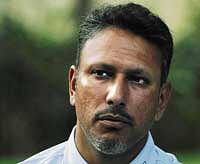'Access to facilities is important'

Jeev Milkha Singh, without a shadow of doubt, is one of the chief architects of golf in India. His exploits in Asia, Europe and US have instilled confidence in many youngsters at home. During a chat with Deccan Herald on his visit to Bangalore, the 38-year-old Padama Shree-award winner shared his thoughts on how to develop the game in the country. Excerpts.
Golf is indeed growing at a good pace in India. However, it is still considered by many as a game of the affluent. What should be done in order to spread it to the masses?
I think two ways in which it is going to get famous is through media’s help and government support of setting up public driving ranges. I am not asking for public golf courses, but just public driving ranges. The government can allocate certain amount of land in setting up the driving ranges so that a common man’s child can have a start by hitting a few balls. Many pick up cricket and football because of the free access to grounds. Otherwise, golf would be restricted only to club members with the others thinking it is too expensive.
With calendars getting tighter and tighter, injuries are on the higher side. Since, you have been through one, what advice do you have for others?
I think, you got to respect an injury. What I mean by that is, once diagnosed of an injury, if the doctor says you have to take six weeks off one has to do that. But the biggest drawback is many of us feel good within three weeks and are eager to make a comeback. That is a big mistake, just like I made. Three weeks after being injured and I felt fine and decided to play the US Open because it was a major. Eventually, the six-week recovery period extended into a three-month lay-off.
Your comments on the newly-introduced ‘Maximum Divisor’ rule, which is designed to diminish current concerns that players might be penalised for playing a significant number of tournaments.
I believe it is fantastic. It is the best thing that could have happened to me (laughs). I play a lot of tournaments and I think I am going to gain from that. It is good not only for me personally, but also for the players and public as it encourages the top golfers to play more often. And, there is a bonus too as they get more world ranking points. Also, if you play more than 60 tournaments in two years, the bad ones are thrown away and the best ones taken from the 60.
You are one of the most travelled players. How do to you battle exhaustion?
Talking about tournaments, I am cutting back on the number. Instead of 40, I shall be playing about 30-35 a year. Battling exhaustion? I just love playing tournaments. I feel the more I play the better I get. The jetlags I cope up with by staying awake whichever country I go to. And physical fitness, I train three times a week – Tuesdays, Thursdays and Saturdays. I also do yoga six days a week.
Comments on three rising stars of Indian golf – Gaganjeet Bhullar and Bangalore’s Anirban Lahiri and C Muniyappa.
They are fantastic. However, the talent is limited not just to three but others like Shiv Kapur, Himmat Rai and SSP Chowrasia. All these guys are young and have a lot of fire in their belly and want to prove themselves. If I was a 21-year-old, I would say “Man, that is Jeev Milkha Singh, I want to do better than him. If he is in top-30 in the world I want to be in the top-10.” That is the drive I would want, but all depends on how hard they can push themselves. What’s important is the mental toughness which can be achieved by playing more tournaments.
Many youngsters here consider you like the father figure in golf. How do you feel about it?
It is great to have that respect. But, my main goal is to do well and it’s up to them to give respect.
You’ve played on PGA, European and Asian tours. Comments on all three…
All three are fantastic. Asian Tour is a brilliant stepping stone for golfers graduating from India, following which they can move to Europe and United States or Japan. I think the standards in US and Europe is the same. If you can play there you can play anywhere in the world, because you are constantly playing with the best in the world. Playing on various tours also helps you become a global player.
Courses in the US are specifically designed and cater to different challenges whereas Europe is more natural and you keep fighting natural conditions like rain and wind very often. Asia is about heat and humidity. Playing across the world brings the best in you.
Golfing greats have set-up tournaments to encourage talent. Do you intend to do something like that here?
Yes, I am planning to host a pro and an amateur tournament. Callaway -- for whom I’ve been signed up as the brand ambassador for India -- is interested in that.
There are plans to host a Jeev Milkha Singh Invitational tournament, depending on my talks with Callaway as well as many other companies. Hopefully, this year, or at least by next, I should be hosting a tournament.
Name three of your favourite courses and why?
Personal favourite is the Augusta Masters, because of the history behind it, the atmosphere, its beauty and greens. It is just fantastic. I can’t get down to second and third because it is really tough.